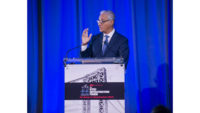VHB/Eng-Wong, Taub and PB: Building Client Relationships with Social Media


One of the positive outcomes that firms report in using social media is building rapport with clients. Often, it evolves from teaming with them to help make information about projects available to the public.
Jeffrey M. Taub, senior marketing specialist for VHB + Eng-Wong, Taub (http://www.vhb.com), says his planning and transportation consulting firm has used Twitter to help promote many of its clients’ projects, as the clients themselves realize they can use Twitter to engage their communities. “We want to help them move away from static websites to more dynamic, interactive engagement with customers,” he says.
Darrel W. Cole, manager of the communications and public involvement group at Parsons Brinckerhoff (http://www.pbworld.com), agrees. To create a strategic benefit for a public-agency client and the firm, staffers have to put the “social” into social media, he says. That means going beyond simply pushing out information. “Are you answering questions, posing questions, sharing the day's weather, saying good morning, sharing important information that will help [the public] during a weather event or some natural disaster, or sharing community information [about, for example] events?” he asks.
If you do, that's when the public will see the project and construction team in a different light. “It's the [moment when they realize] ‘Oh, they really do care about how they are impacting me.’ Now that's powerful.” The analogy Cole uses is the local coffee shop. “Would you go in every day and say nothing? No. Most people will engage at least politely back. Why wouldn't you do the same to the people who are following you on social media?”
VHB has used Twitter to help promote clients’ projects with their customers—in the case of PATH and MTA—and citizens, in the case of counties and municipalities. The New York City Dept. of Transportation, for example, promoted public hearings and workshops for the Hylan Boulevard transportation study through Twitter, and VHB re-tweeted their posts and created its own. Morris County in northern New Jersey actively tweets project news, as well, and VHB retweets. For example:
• RT @NYC_DOT: Join us for a public meeting on Hylan Boulevard in Staten Island. Thurs Sep 15 at 7PM http://on.fb.me/nFfhFV
• Join VHB and the @AECOM team at #StatenIsland Hylan Boulevard Bus Study meeting: http://bit.ly/nzEjAz
Taub believes the most important aspect of this effort “is that we’re doing this on our own. The client isn’t paying us to tweet and promote their work, but we feel it’s important that the public is presented with every opportunity to learn more about local projects and neighborhood improvement plans,” he says. Even for projects where work wrapped up several years ago, the firm uses Twitter to congratulate clients. For example:
• Great to see Stapleton, Hunters Point South, and many other great @NYCEDC initiatives moving forward
• Congrats to @stevengoldin and our project team! Transit Village #TOD approved at #Princeton Junction: http://bit.ly/oya3pM
In 2009, the Port Authority of New York and New Jersey hired VHB + Eng-Wong, Taub to complete customer surveys of PATH riders in the New York City metro area. More than 12,000 in-station, face-to-face interviews were conducted. VHB + Eng-Wong, Taub also wrote a series of tweets that were distributed by PATH’s Twitter account manager and displayed throughout the program on PATHVision monitors to encourage survey participation.
Getting Out Information on the Survey
Susan O’Donnell, VHB + Eng-Wong, Taub project manager, was following "PathTweet" partially because it is a client and also for transit information, and she thought it would be a good way to get information out to PATH customers regarding the survey. Both consultant and client staff collaborated on the messaging. “Several people came right up, asking to participate in the survey, and others mentioned that they heard about it from Twitter,” she said. The strategy boosted the response rate and participation.
PB also is using Facebook and Flickr to communicate with the public on projects such as the interstate widening project in Baton Rouge, La., called Geaux Wider (https://www.facebook.com/geauxwider1). The project’s Facebook page has drawn 70,000 page views a month, compared to the project’s website page-view tally of 4,000 or so.
The project is also using the social-media photo site Flickr (http://www.flickr.com/photos/geauxwider/) as “a key component” of its program, Cole adds. “The images of real people doing real work help make the public see the project from the workers' eyes and humanizes it, even though it is impacting their travel every day,” he says.
Thanks Jan for including me and my company in the story. We have excellent clients -- Louisiana DOTD, Michigan DOT, Connecticut DOT, City of Ann Arbor, MI, and G.E.C. Inc of Baton Rouge...
www.facebook.com/hueypbridge
www.twitter.com/hueypbridge
www.facebook.com/geauxwider1
www.twitter.com/geauxwider
www.facebook.com/annarborbridges
www.twitter.com/annarborbridges
www.twitter.com/NHHSrail
Darrel W. Cole
Parsons Brinckerhoff






